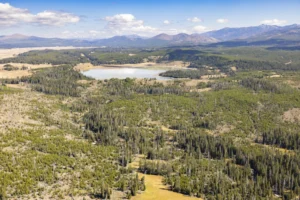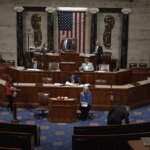Snow-packed, Forested Lands are Water Reservoirs
State lawmaker argues that better forest management could yield more water in drought-afflicted West
- Published In: Other News & Features
- Last Updated: Sep 14, 2023

The Colorado River is seen near Palisade, Colorado in July. Although plagued by a decades-long drought, the river supplies drinking water to around 40 million people in the seven states included in the Colorado River Basin. (Wyoming Truth photo by Carrie Haderlie)
By Carrie Haderlie
Special to the Wyoming Truth
Better forest management practices could lead to increased water yield, as a historic 23-year drought continues to plague the West.
“Water, fire and forests are all interrelated and interdependent,” Sen. Larry Hicks (R-Baggs), who also serves as natural resource coordinator for the Little Snake River Conservation District, said Tuesday at a joint meeting of the Agriculture, State and Public Lands and Water Resources Committee and the Select Water Committee in Pinedale.
Speaking in his professional capacity rather than as a senator, Hicks gave a detailed presentation on water yield and forest management. Simply put, Hicks argued that dense, dead trees that are not cleared away in the process of active forest management negatively impact stream flows out of national forests, subsequently impacting drought afflicted areas in the West.
The meeting comes as forest management plans for the Bridger-Teton, the Black Hills and the Medicine Bow National Forests are all under way. Both committees also heard from Wyoming State Forest Division and Forest Service representatives.

The Bridger-Teton plan, for example, has not been updated since 1990 and is in the first phase of updates.
“This whole issue of water yield, at some point in time, is going to come to a boiling point,” Hick said. “I see the [Bridger-Teton] as the big picture item here … with the amount of water that is generated in the Bridger Teton National Forest.”
Federal forest policy often drives the timber industry, which affects water yield. Forest management policy can drives fire occurrence, he said, which can also impacts water yield. Ultimately, Hicks said, discrepancies in state and federal forest management best practices can lead to water loss in the West.
Referencing a 2000 hydrological study that found that timber harvest can reduce “evapotranspiration and increase stream flows,” Hicks argued that an increase in forest density could have resulted in a decrease in average annual streamflow of 160,000 acre-feet per year in the North Platte River. Subsequent Forest Service decisions regarding forest density could have caused an additional loss of 27,000 acre feet leading up to the year 2017, Hicks said.
Rocky Mountain Forests are Colorado River Basin’s ‘biggest reservoir’
Wyoming is one of seven states in the Colorado River Basin, which provides drinking water to 40 million people. Approximately 155,000 Wyomingites, or 28% of the state’s population, gets all or a portion of their drinking water from the Colorado River Basin.
Wyoming’s share of the runoff in the Colorado River Basin, or about 15%, comes from the Green River Basin, the “very headwaters of the Colorado,” Hicks said. The “largest reservoir” in the seven-state system is not Lake Mead or Lake Powell. Instead, he said, it’s the snow-capped peaks of the Rocky Mountains.
“The largest reservoir in the Colorado River Basin is the snowpack on the national forest. Our high-elevation snowpack. That is where all that [water] the Bureau of Reclamation receives later [comes from], and they then try to manage,” he said. “Seventy percent of all the water in the Colorado River Basin comes out of the snowpack. So what are we doing to manage the snowpack?”
It would stand to reason, Hicks said, that the Forest Service is the largest reservoir manager within the Colorado River Basin, which leads to another question.
“Can vegetation management lead to an increase in water yield?” Hicks said. “The simple fact is that we can manage forested landscapes for increased water yield. … We can also do that in the context of other multiple-use benefits.”
Partners or adversaries?
In a sweeping discussion, stakeholders from federal and state agencies, as well as lawmakers, discussed how best to manage Wyoming’s forested state and federal lands. Sen. Mike Gierau (D-Jackson) asked Wyoming State Forester Kelly Norris about her agency’s relationship with its federal partners.
“Specifically, in regards to [the Forest Service] starting their [Bridger Teton] forest plan, do you feel you have a seat at the table?” Gierau said.

“I think our relationship has room to grow and improve,” Norris responded. “We have met with our federal partners, and we are starting to look at how we can use a shared stewardship agreement working towards where our priorities are in the state.”
Later in the meeting, Sen. John Kolb (R-Rock Springs) asked Jacque Buchanan, deputy regional forester with the USFS Rocky Mountain Regional Office, if the agency does consider the state its partner.
“I am very apprehensive on this word, ‘cooperating agency’ … my understanding of ‘negotiating’ is that it is a give-and-take,” Kolb said. “I haven’t heard of you guys [the Forest Service] giving up much of anything when it comes to [forest management decisions].”
Buchanan said the Forest Service not only considers state and local governments as its partners, but also takes other voices into account. Nonprofit agencies like the Nature Conservancy have a voice, and the Forest Service must engage neighboring states in forest management discussions as well.
“Sometimes, we are dealing with a government that is very different, even at that state level,” Buchanan said. “In the Black Hills, Wyoming and South Dakota are fairly similar, in hydrological approach and core issues. But sometimes, Wyoming and Colorado, we can have some differences there.”
Kolb said the agencies must do a better job collaborating or they will end up as adversarial “litigation partners.”
Ultimately, Hicks said it is the state of Wyoming that needs to upscale its technical abilities to advocate for its forest management position at a federal level.
“Sometimes, it feels to me like … going to the federal court system is, they are Harvard lawyers and the State of Wyoming is a bunch of kindergartners, because we refuse to provide the expertise and the technology and the abilities to be able to compete at that scale,” Hicks said.













